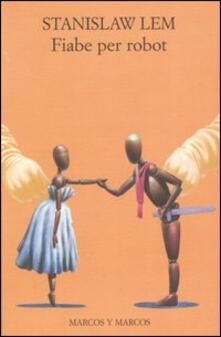 Robots. Much time has past since the definition of “robot” although the idea of an artificial being created by men dates a long back. The current idea of robot includes electronics and software supplanting what was considered back in the fifties and in the sixties (of the past century) when a robot was built from gears, springs and occasional electricity wires. The brain was made by something yet to be invented then, so every author imagination could go wild on this. In this book brains are either made by mercury or by antimatter…. well to be honest still today we don’t know what exactly is supposed to fill the cloud depicted on robot schematics labeled with “brain”. We know how to build simple mechanism… basically computers on wheel, but we are quite far from devising a fully featured robot as presented in sci-fi literature. This is the fourth book by Stanislaw Lem that I read. I found the first two (Eden and Fiasco – “Il pianeta del silenzio” in Italian) to be really great. They are mainly focused on how much alien can be alien. Beings living in remote and insulated region of space could well spoil behaviors that we could hardly identify as rational or intelligent.
Robots. Much time has past since the definition of “robot” although the idea of an artificial being created by men dates a long back. The current idea of robot includes electronics and software supplanting what was considered back in the fifties and in the sixties (of the past century) when a robot was built from gears, springs and occasional electricity wires. The brain was made by something yet to be invented then, so every author imagination could go wild on this. In this book brains are either made by mercury or by antimatter…. well to be honest still today we don’t know what exactly is supposed to fill the cloud depicted on robot schematics labeled with “brain”. We know how to build simple mechanism… basically computers on wheel, but we are quite far from devising a fully featured robot as presented in sci-fi literature. This is the fourth book by Stanislaw Lem that I read. I found the first two (Eden and Fiasco – “Il pianeta del silenzio” in Italian) to be really great. They are mainly focused on how much alien can be alien. Beings living in remote and insulated region of space could well spoil behaviors that we could hardly identify as rational or intelligent.
The third book was “Solaris” although focused on the same subject the narrative pace is extremely slow. The story is much oriented to introspection and character psychology.
My expectations for Robot Tales were quite high, so I was rather disappointed to find a collection of children stories. Robots are just and excuse for telling space stories. Some of the stories are pretty well written and touchy, some are just variation of the king-promising-his-daughter-to-the-one-who-will-do-something.
One of the main features of the book is being precise about astronomy science. Stars, nuclear reactions, radioactivity and so on are woven in the stories with a good degree of accuracy. This is intriguing (at least for the engineers within me), but is untuned with the robot description that is far from scientific accuracy.
It is hard to find a reader profile for this book. Children can be easily bored by scientific description, while teenagers are surely dissatisfied by the plots.
Note that the book is published in Italy with the title “Fiabe per Robot” (Tales for Robots) while in english has been translated into two volumes – “Mortal Engine” and “The Cosmic Carnival of Stanislaw Lem“